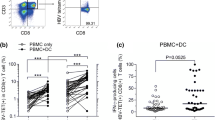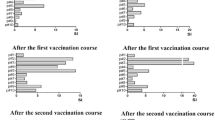Abstract
Hepatitis B virus (HBV) is a noncytopathic DNA virus and is the pathogen of acute and chronic hepatitis. Interferon and nucleotide analogues such as lamivudine and adefovir are the current treatment strategies of HBV infection; however, it is still a serious disease. Therefore, the development of new therapeutic options against HBV is needed. In the present study, we have investigated whether the vectors carrying short hairpin RNA (shRNA) targeting the murine B7-DC gene could silence the expression of B7-DC and analyzed the function of gene-modified dendritic cells (DCs) by mixed lymphocyte reaction. The results demonstrated that two shRNA vectors efficiently suppressed the expression of B7-DC. The MLR assay showed that shRNA-B7-DC-transfected DCs induced markedly higher allogeneic lymphocyte proliferation than transfected DCs with the vector plasmid pAS and untreated DCs at all dilutions. The most efficient shRNA plasmid vector against B7-DC was then used to silence the expression of B7-DC on DCs, the gene-modified DCs were pulsed with HBV-specific peptides, and HBV transgenic mice were immunized. After three rounds of immunization, the splenocytes were stimulated in vitro and tested for cytotoxicitic T lymphocyte activity, while the sera were used to detect the level of HBsAg and HBV DNA. The data demonstrated that blockade of B7-DC on DCs augmented the cytolytic activity induced by immunization with peptide-pulsed DCs and significantly reduced the concentration of serum HBsAg and HBV DNA, suggesting that silencing of B7-DC is of potential value in DC-based therapy of HBV infection.




Similar content being viewed by others
References
Akbar SK, Onji M (1998) Hepatitis B virus (HBV)-transgenic mice as an investigative tool to study immunopathology during HBV infection. Int J Exp Pathol 79:279–291
Alexander-Miller MA, Leggatt GR, Berzofsky JA (1996) Selective expansion of high-or low-avidity cytotoxic T lymphocytes and efficacy for adoptive immunotherapy. Proc Natl Acad Sci USA 93:4102–4107
Banchereau J, Steinman RM (1998) Dendritic cells and the control of immunity. Nature 392:245–252
Bass BL (2000) Double-stranded RNA as a template for gene silencing. Cell 101:235–238
Chen C, Qu QX, Huang JA, Zhu YB, Ge Y, Wang Q, Zhang XG (2007) Expression of programmed-death receptor ligands 1 and 2 may contribute to the poor stimulatory potential of murine immature dendritic cells. Immunobiology 212:159–165
Chen Y, Cheng G, Mahato RI (2008) RNAi for treating hepatitis B viral infection. Pharm Res 25:72–86
Chen Y, Du D, Wu J, Chan CP, Tan Y, Kung HF, He ML (2003) Inhibition of hepatitis B virus replication by stably expressed shRNA. Biochem Biophys Res Commun 311:398–404
Coyle AJ, Gutierrez-Ramos JC (2001) The expanding B7 superfamily: increasing complexity in costimulatory signals regulating T cell function. Nat Immunol 2:203–209
Fire A, Xu S, Montgomery MK, Kostas SA, Driver SE, Mello CC (1998) Potent and specific genetic interference by double-stranded RNA in Caenorhabditis elegans. Nature 391:806–811
Freeman GJ, Long AJ, Iwai Y, Bourque K, Chernova T, Nishimura H, Fitz LJ, Malenkovich N, Okazaki T, Byrne MC, Horton HF, Fouser L, Carter L, Ling V, Bowman MR, Carreno BM, Collins M, Wood CR, Honjo T (2000) Engagement of the PD-1 immunoinhibitory receptor by a novel B7 family member leads to negative regulation of lymphocyte activation. J Exp Med 192:1027–1034
Huang WS, Wang JP, Wang T, Fang JY, Lan P, Ma JP (2007) ShRNA-mediated gene silencing of β-catenin inhibits growth of human colon cancer cells. World J Gastroenterol 13:6581–6587
Inchauspé G, Michel ML (2007) Vaccines and immunotherapies against hepatitis B and hepatitis C. J Viral Hepat 14:97–103
Iwasaki Y, Ikeda H, Araki Y, Osawa T, Kita K, Ando M, Shimoe T, Takaguchi K, Hashimoto N, Kobatake T, Tomita M, Kawaguchi M, Kobashi H, Sakaguchi K, Shiratori Y (2005) Limitation of combination therapy of interferon and ribavirin for older patients with chronic hepatitis C. Hepatology 43:54–63
Jiang WZ, Jin NY, Li ZJ, Zhang LS, Wang HW, Zhang YJ, Han WY (2005) Expression and characterization of Gag protein of HIV-1(CN) in Pichia pastoris. J Virol Methods 123:35–40
Kanda T, Steele R, Ray R, Ray RB (2007) Small interfering RNA targeted to hepatitis C virus 5’ nontranslated region exerts potent antiviral effect. J Virol 81:669–676
Kayhan H, Karatayli E, Turkyilmaz AR, Sahin F, Yurdaydin C, Bozdayi AM (2007) Inhibition of hepatitis B virus replication by shRNAs in stably HBV expressed HEPG2 2.2.15 cell lines. Arch Virol 152:871–879
Latchman Y, Wood CR, Chernova T, Chaudhary D, Borde M, Chernova I, Iwai Y, Long AJ, Brown JA, Nunes R, Greenfield EA, Bourque K, Boussiotis VA, Carter LL, Carreno BM, Malenkovich N, Nishimura H, Okazaki T, Honjo T, Sharpe AH, Freeman GJ (2001) PD-L2 is a second ligand for PD-1 and inhibits T cell activation. Nat Immunol 2:261–268
Lavanchy D (2004) Hepatitis B virus epidemiology, disease burden, treatment, and current and emerging prevention and control measures. J Viral Hepat 11:97–107
Lenschow DJ, Walunas TL, Bluestone JA (1996) CD28/B7 system of T cell costimulation. Annu Rev Immunol 14:233–258
Linsley PS, Clark EA, Ledbetter JA (1990) T-cell antigen CD28 mediates adhesion with B cells by interacting with activation antigen B7/BB-1. Proc Natl Acad Sci USA 87:5031–5035
Liu X, Gao JX, Wen J, Yin L, Li O, Zuo T, Gajewski TF, Fu YX, Zheng P, Liu Y (2003) B7DC/PDL2 promotes tumor immunity by a PD-1-independent mechanism. J Exp Med 197:1721–1730
Ludewig B, Ehl S, Karrer U, Odermatt B, Hengartner H, Zinkernagel RM (1998) Dendritic cells efficiently induce protective antiviral immunity. J Virol 72:3812–3818
McIntyre GJ, Fanning GC (2006) Design and cloning strategies for constructing shRNA expression vectors. BMC Biotechnol 6:1
Nishimura H, Nose M, Hiai H, Minato N, Honjo T (1999) Development of lupus-like autoimmune diseases by disruption of the PD-1 gene encoding an ITIM motif-carrying immunoreceptor. Immunity 11:141–151
Nishimura H, Okazaki T, Tanaka Y, Nakatani K, Hara M, Matsumori A, Sasayama S, Mizoguchi A, Hiai H, Minato N, Honjo T (2001) Autoimmune dilated cardiomyopathy in PD-1 receptor-deficient mice. Science 291:319–322
Peng G, Li S, Wu W, Tan X, Chen Y, Chen Z (2008) PD-1 upregulation is associated with HBV-specific T cell dysfunction in chronic hepatitis B patients. Mol Immunol 45:963–970
Rodig N, Ryan T, Allen JA, Pang H, Grabie N, Chernova T, Greenfield EA, Liang SC, Sharpe AH, Lichtman AH, Freeman GJ (2003) Endothelial expression of PD-L1 and PD-L2 down-regulates CD8+ T cell activation and cytolysis. Eur J Immunol 33:3117–3126
Saas P, Tiberghien P (2002) Dendritic cells: to where do they lead? Transplantation 73:S12–S15
Seibler J, Kleinridders A, Küter-Luks B, Niehaves S, Brüning JC, Schwenk F (2007) Reversible gene knockdown in mice using a tight, inducible shRNA expression system. Nucleic Acids Res 35:e54
Seo SK, Seo HM, Jeong HY, Choi IW, Park YM, Yagita H, Chen L, Choi IH (2006) Co-inhibitory role of T-cell-associated B7–H1 and B7-DC in the T-cell immune response. Immunol Lett 102:222–228
Tseng SY, Otsuji M, Gorski K, Huang X, Slansky JE, Pai SI, Shalabi A, Shin T, Pardoll DM, Tsuchiya H (2001) B7-DC, a new dendritic cell molecule with potent costimulatory properties for T cells. J Exp Med 193:839–846
Usharauli D (2005) Dendritic cells and the immunity/tolerance decision. Med Hypotheses 64:112–113
Webster GJ, Reignat S, Brown D, Ogg GS, Jones L, Seneviratne SL, Williams R, Dusheiko G, Bertoletti A (2004) Longitudinal analysis of CD8+ T cells specific for structural and nonstructural hepatitis B virus proteins in patients with chronic hepatitis B: implications for immunotherapy. J Virol 78:5707–5719
Yang S, Tsang KY, Schlom J (2005) Induction of higher-avidity human CTLs by vector-mediated enhanced costimulation of antigen-presenting cells. Clin Cancer Res 11:5603–5615
Yao V, Platell C, Hall JC (2002) Dendritic cells. ANZ J Surg 72:501–506
Zhang BJ, Zhou J, Qu D, Siu KL, Lam TW, Lo HY, Lee SS, Wen YM (2004) Selective functional deficit in dendritic cell-T cell interaction is a crucial mechanism in chronic hepatitis B virus infection. J Viral Hepat 11:217–224
Zhang Y, Chung Y, Bishop C, Daugherty B, Chute H, Holst P, Kurahara C, Lott F, Sun N, Welcher AA, Dong C (2006) Regulation of T cell activation and tolerance by PDL2. Proc Natl Acad Sci USA 103:11695–11700
Zhao J, Wei XL, Jia YS, Zheng JQ (2008) Silencing of herg gene by shRNA inhibits SH-SY5Y cell growth in vitro and in vivo. Eur J Pharmacol 579:50–57
Acknowledgements
This work was supported by grants from National Natural Science Fund of China (30400070) and Shanghai Rising-Star Program (06QA14017).
Author information
Authors and Affiliations
Corresponding author
Rights and permissions
About this article
Cite this article
Fan, Y., Jiang, WZ., Wen, JJ. et al. B7-DC-silenced dendritic cells induce stronger anti-HBV immunity in transgenic mice. Arch Virol 154, 1813–1821 (2009). https://doi.org/10.1007/s00705-009-0521-7
Received:
Accepted:
Published:
Issue Date:
DOI: https://doi.org/10.1007/s00705-009-0521-7




